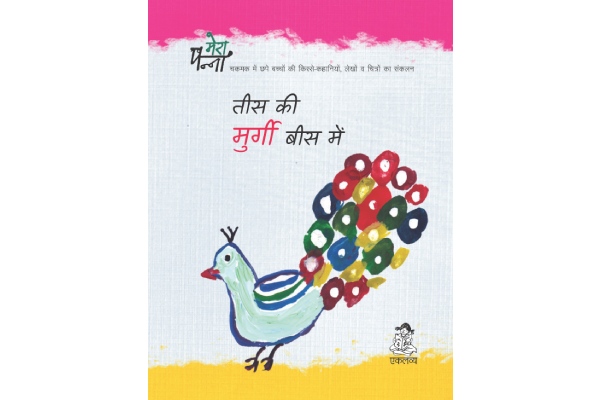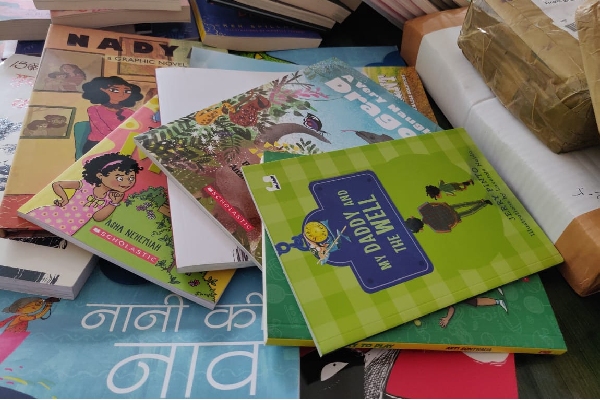
Loading...

Loading...
Book: I Can Hear the Sun
Publisher: Puffin Books
“We could all fly once. We just forgot how.
If we’d think hard enough, we’d remember.”
This July one of Children’s Literature’s most prolific and loved author and illustrator Patricia Polacco completed over 38 years of writing for children. She stared writing for children fairly late, at age 40 and has written over 115 children’s books. Her books reflect warm family stories from her childhood mostly about living with an immigrant family and featuring her family members – grandparents, siblings and cousins as protagonists. In an interview to reading rockets she once said “ I was raised in a household where old members of the family lived with us. And there was something wonderful about sitting at their knee and listening to how things ‘were’. And it gave us a sense of our place. It gave us a sense of our birth order. It gave us a sense that we were loved long before we were even born”.
Throughout her school years, Polacco struggled with reading but found relief by expressing herself through the arts. While being bullied at school, she hid her disability until a school teacher recognized that she could not read and began to help her. One of her most popular books, Thank You, Mr. Falker is a retelling of this encounter and its outcome, and her tribute to her beloved teacher. Her other popular titles include The Keeping Quilt, The Blessing Cup, Thunder Cake, Babuskha’s Doll, Babushka Baba Yaga, and the Lemonade Club.
While I love most of her writings, a book that I love the most and feel always drawn to is I Can Hear the Sun. I can hear the Sun by Patricia Polacco is located in Lake Merritt in Oakland, California. It’s a lake where many people who are marginalized by society live. Throwaway people, they are called. Fondo, a young, homeless orphan, who lives in a settlement house for unwanted children, is one among them. Initially lonely, he is urged by Stephanie Michele who is a caretaker at the science centre and bird sanctuary to feed and take care of the birds, especially a gaggle of geese. The sensitivity and empathy in Stephanie’s voice and the new friendship that he makes with Will Jack, and Mae Marie, other homeless people at the lake, allows him to break his silence and open up to the environment at Lake Merritt. Fondo quickly becomes fond of his new friends and attached to a blind goose from the flock who follows him everywhere.
One day Fondo comes to the park and reveals to Stephanie that the settlement house is sending him away because they have diagnosed him to be a ‘slow learner’. He is deeply sad, and does not want to leave all that he has at Lake Merritt, especially the deep friendship that he shares with the blind goose. Stephanie tries to talk to Doctor Patterson at the settlement house but he refuses to let Fondo stay. Soon Fondo starts to express that the flock of geese have invited him to go with them.
One evening, while the settlement house people were arranging for his departure, Fondo runs away and comes to the park. As the geese begin to fly away, something of a miracle occurs. Fondo also lifts off from the ground and flies up into the sky with his geese friends.
Stephanie, Mae Marie and Willy Jack vow not to tell anyone about what happened to Fondo, the homeless child who flew away with the geese. Who would believe such a thing? The settlement house searches for Fondo for a few days and then adds his name to a long list in a thick dusty file. No one sees Fondo again.
I Can Hear the Sun is a beautifully crafted and sensitively written story. Excellently produced by Puffin Books, each page through its text and illustrations depicts the fragility and vulnerability of a lonely, orphaned child, Fondo, and the humanity in those who we consider outcasts.
This story is an ode to great friendships- friendships created beyond race, age, ethnicity, and the human-animal divide. Such was the friendship and bond between the characters – Fondo, Stephanie Michele, Willy Jack, Mae Marie and the blind goose at Lake Mirrette. The book shows how each of them came to recognize one another’s loneliness, and built bonds that strengthened their faith in love and life.
The story depicts, with great dignity, the life of people who are considered unwanted in our society – an orphaned child, a war veteran, a homeless woman, a caretaker of a bird sanctuary. It shows intimately how each of their lives is rich because of the connect they share through friendship, acceptance and empathy.
The story also raised an important question – Where is home? Or rather where do we make our homes? For Stephanie it seemed like home was not where she went back to at the end of the day. Her home was in all that she had created at Lake Merritt. For Mae Marie, it was not in the cart that she carried that held her possessions, but in the relationships that she built with her friends. For Fondo, it was not in the shelter that housed him, but in the compassionate arms of Stephanie and in the affection and tenderness that he felt around the blind goose. Homes are not physical spaces – they are a feeling created by a sense of safety and acceptance that nourishes us.
The story is considered a modern myth. What stands out in the story is the way the central conflict is resolved. Fondo’s settlement home wants to send him off to another home where he can be taken care of, because he is considered a child with special needs. But Fondo doesn’t want to leave his friends, especially the blind goose at Lake Merritt. Fondo is invited by the flock of geese, led by the blind goose, who are migrating out of the lake as winters approach. In the end, Fondo is seen flying away with the geese and disappearing into the sky. While most of what is dealt with in the story are real issues of the characters – loneliness, poverty, parentless-ness, struggles with the child care system etc, the miraculous end of the story makes sense when we accept a willing ‘suspension of disbelief’. The sudden end could seem a little too surprising to some but this is where the story moves from realism to myth.
This seems like Polacco’s style. In an interview she talks about how as children she and her brother heard stories from her Russian grandmother. The grandmother would tell some of the most fascinating stories around the evening fireside. At the end of the story, Polacco would lean towards her and ask, “That story that you told us, is it a true story?” Grandmother would look at the kids over her glasses and reply, “I’ve gotta say true story. But it may not have happened”
This is exactly the feeling that Polacco creates in her readers by telling such beautiful stories that are true, soulful and full of hope – but not may not fit into the normal framework and understanding of reality.
The illustrations are by Patricia Pollaco herself. They are vibrant and telling. The earthy tones capture the vulnerability and fragility of Fondo, the grit and determination of Stephanie Michele and the mystery in the animals and atmosphere at Lake Merritt. None of the illustrations are framed. This creates the illusion that the reader is in the location, and is able to experience the landscape and the story more intimately. Stephanie’s strong character is set by placing her strategically in most of the pages. She occupies an important spot, is larger in size and appears to be closest to the reader. This builds a greater connect with the character and makes her warmth palpable. The faces of each of the characters are captured in great depth and detail, making them come alive as the story progresses.
I also loved Polaco’s economy in lines and colours especially in the first and last illustration. Both are dedications – To Rufus and to Stephanie. She uses colour only on the face and hands of the characters in a pencil drawn landscape, bringing the focus back on to the intensity in their characters and faces.
Yes, this book is about Fondo, the orphaned child who finally finds his home. But it’s as much Stephnie Michele’s story, who shows the the importance of communicating with nature – the sun, the animals and the environment around her. She shows that the deep sense of love and gratitude it can create for life. She shows the mystery that one accesses through these connects and the several possibilities of miracles that it can unfold. It is this love for nature that truly nourishes Fondo.
…She (Stephanie Michele) is a person well acquainted with the secret ways of animals and hurting souls needing a place to just …be.
Patricia Polacco submitted the draft of this book to Penguin Books in 1995. A few days after she made the submission, she received the news that one of her favourite nephews, Rufus Ambrose Barber died in a tragic car accident. He was only twenty-six years old. Patricia riddled with grief called her publisher and pulled back the draft. She then spent months working on the book, changing all the illustrations, and creating Fondo in the image of her nephew Rufus. She dedicated the book to Rufus Ambrose Barber (30 August 1969 – 10 November 1995).
For all those who love stories about friendship and the power of human connections, this book is a must read. Taking this opportunity to wish one of my favourite children’s authors, Patricia Polacco a very happy birthday. Yes, you and your books were loved, long before they were born.

बाल-साहित्य: किताबों की एक महत्वपूर्ण, अद्भुत और बढ़ती हुई श्रेणी
बच्चों की किताबें अभी भी पढ़ता रहा,कुछ पत्रिकाएँ भी,और इनके लिए कुछ कुछ लिखता भी रहा।…

क्यों ज़रूरी है बाल साहित्य की बेहतरीन किताबों की सूची
बच्चों के सामान्य और स्कूली जीवन में बाल साहित्य की अहमियत को सभी स्वीकारते हैं। बच्चों के चहुँमुखी व्यक्तित्व (समग्र) विकास में साहित्य की महत्त्वपूर्ण भूमिका होती है।…